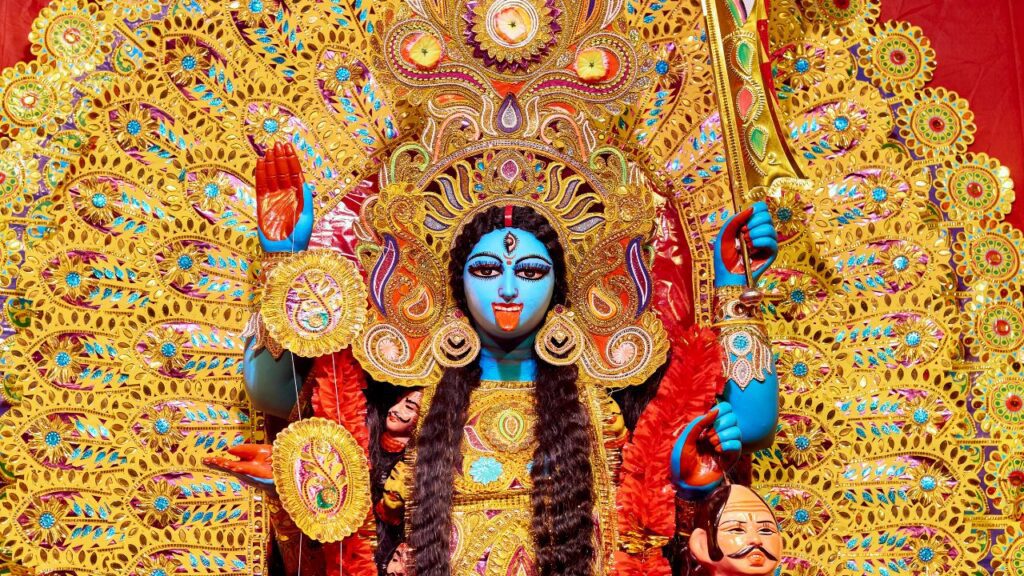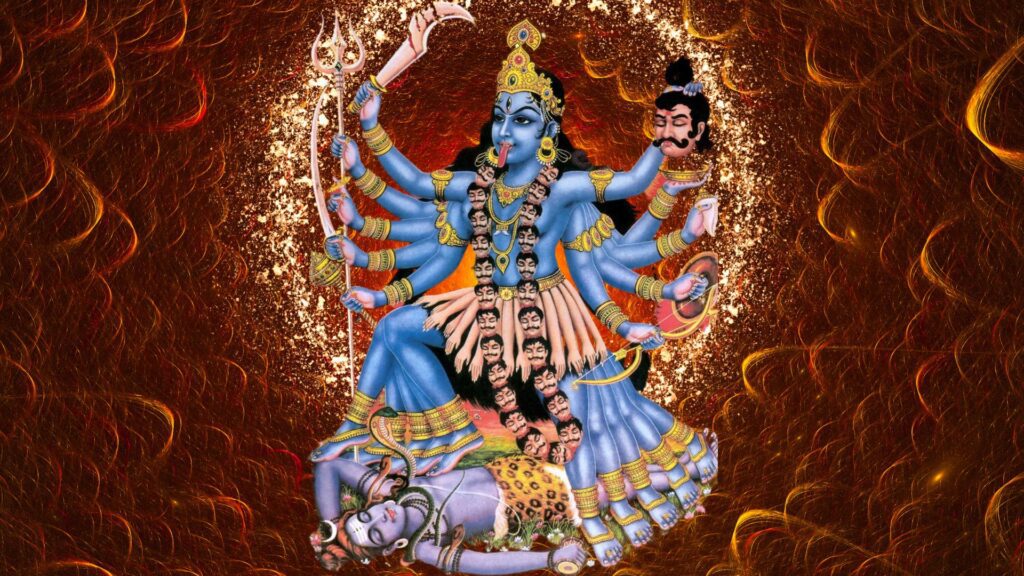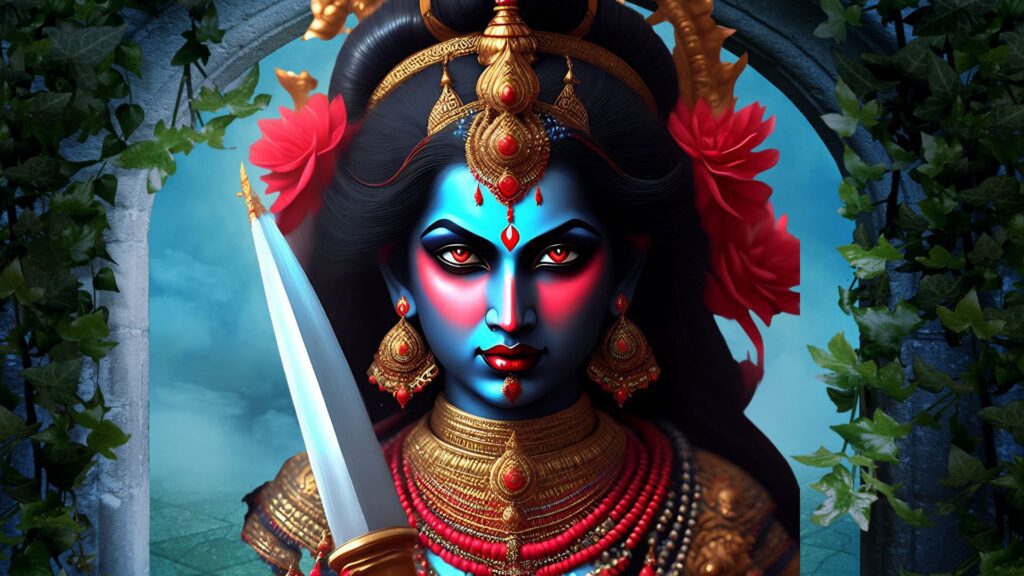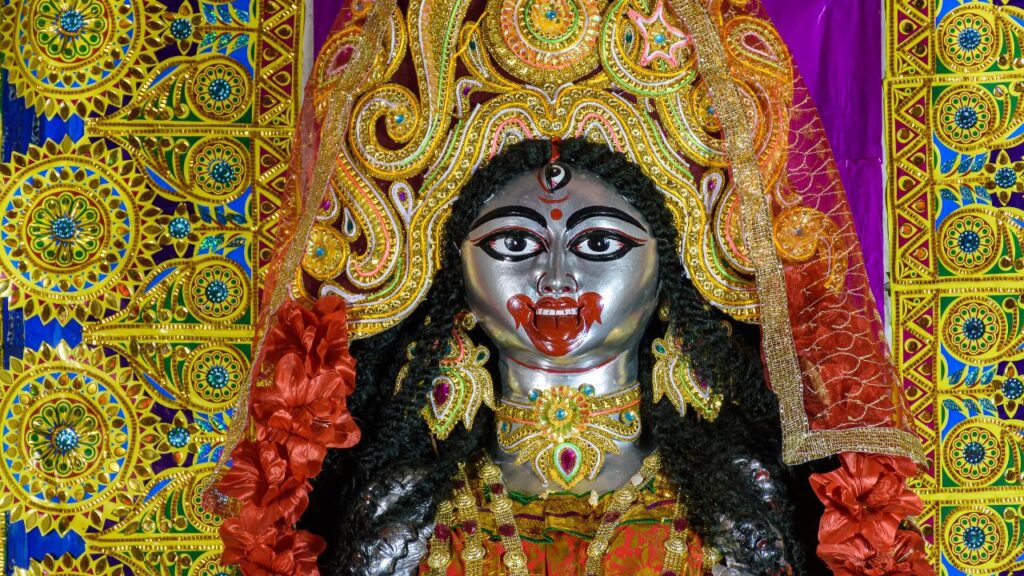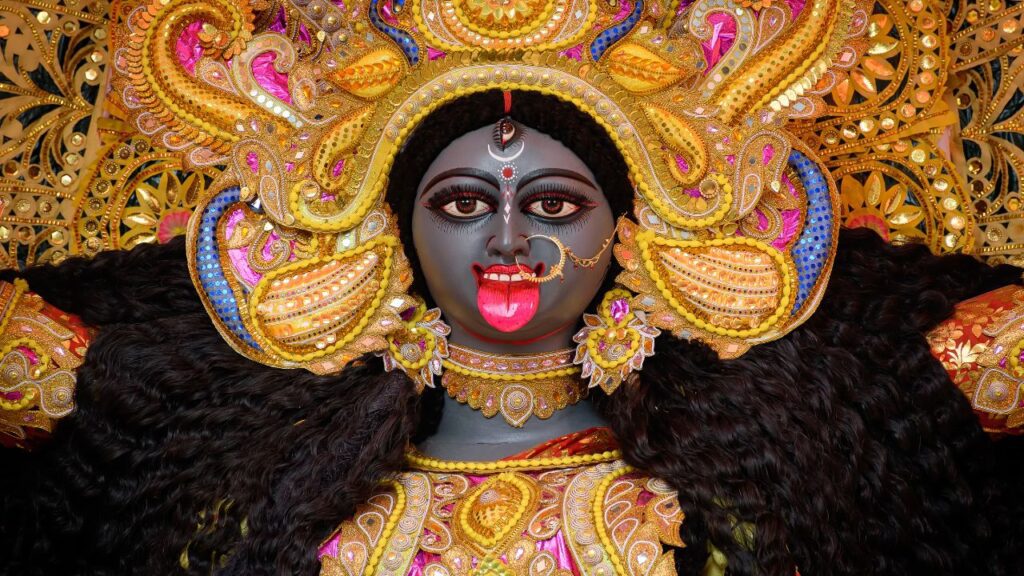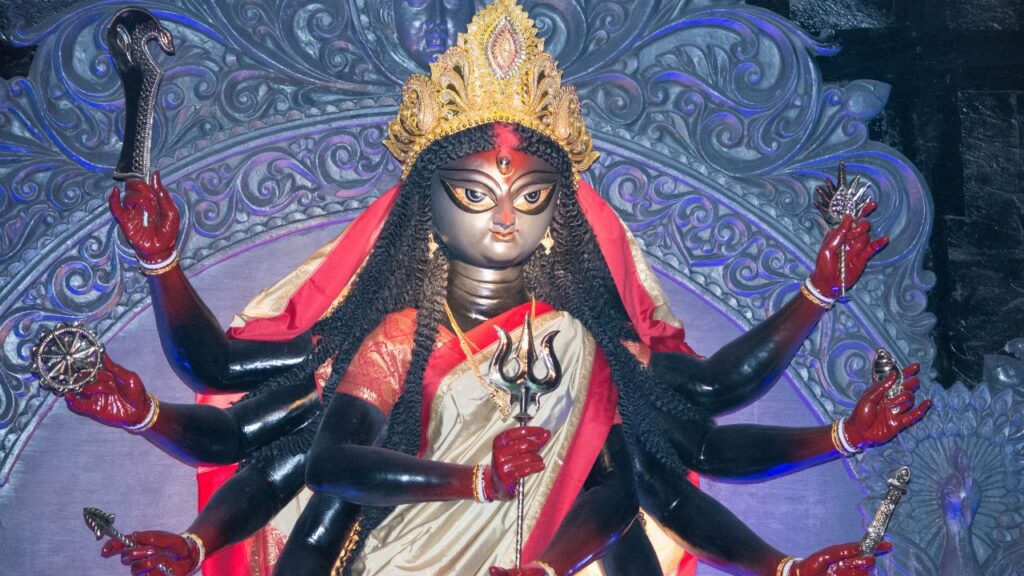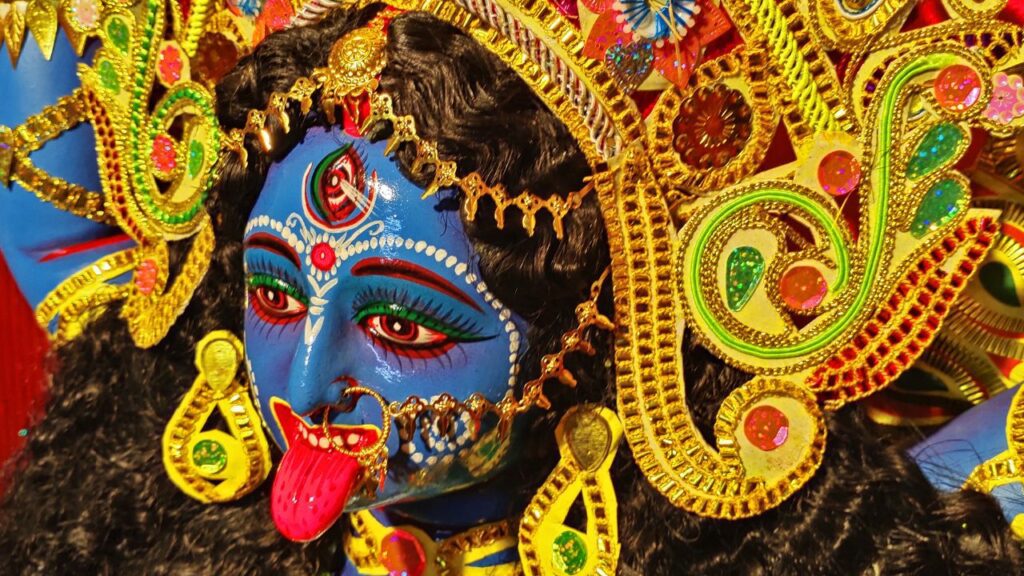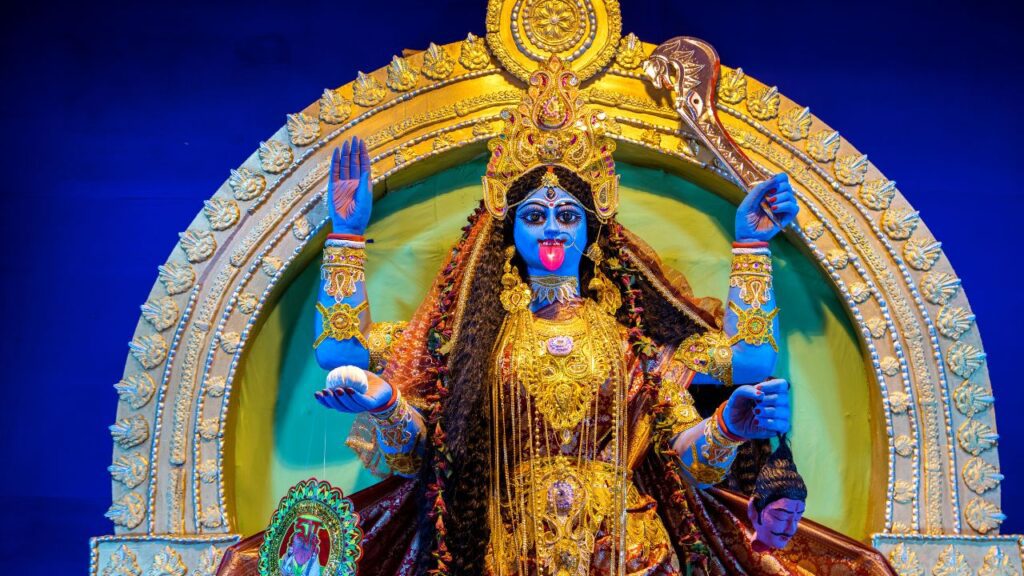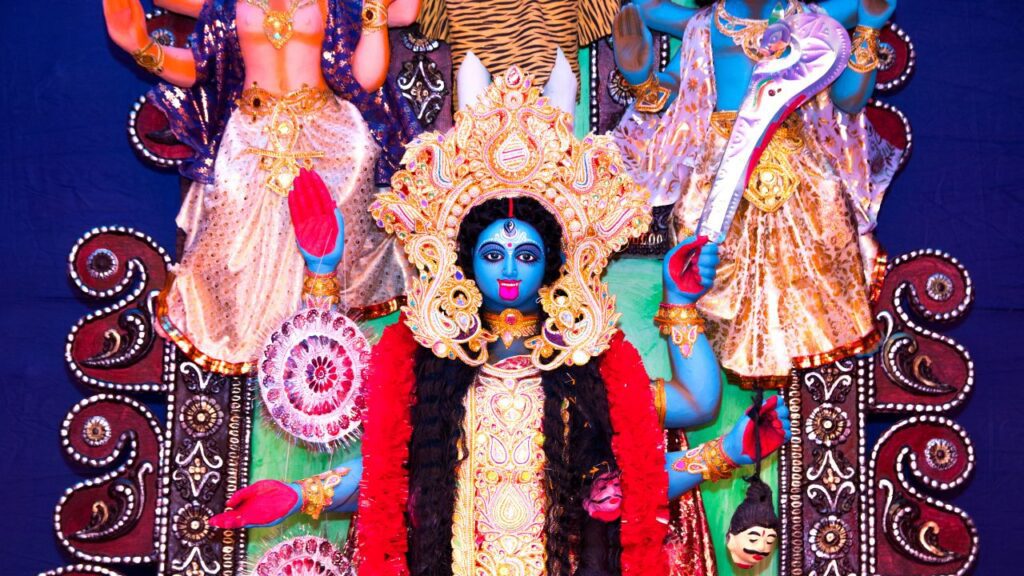Kali Puja: Role of Kali in Hindu Festivals
Introduction
In the Hindu pantheon Goddess Kali, the ferocious and strong form of the Divine Mother, is highly esteemed. Devotees have been enthralled for millennia by her roots, symbolism, and part in many celebrations and rites. This page explores the fascinating stories around Kali and how her dynamic presence changes Hinduism’s spiritual and cultural terrain.
The Emergence of Kali
The Devi Mahatmyam, a revered book within the Markandeya Purana, holds that Goddess Kali’s beginnings can be found in a turning point in the cosmic struggle between the devas—celestial beings—and the asuras—demonic forces. Lead by Indra, the devas took cover with the heavenly trinity of Brahma, Vishnu, and Shiva when the strong Mahishasura routed them. From the collective wrath and strength of these highest creatures, Kali emerged armed with a variety of divine weapons and abilities.
With features taken from the other gods, the book graphically depicts Kali’s terrible look. Her face came from Shiva, her hair from Yama—the God of Death—and her eighteen arms from Vishnu. This blending of celestial forces gave Kali unmatched power and direction: to defeat the asuras and bring the universe back in line.
The Slaying of Mahishasura
The story then opens with Kali, in all her savagery, fiercely fighting the strong Mahishasura. In his several shape-shifting forms, the asura tested Kali’s ability, but she was unconcerned, armed with her variety of divine weapons and driven to get past every challenge.
The turning point occurred when Mahishasura changed into a powerful buffalo—the very essence of his demonic character. With her relentless attention and unflinching determination, Kali finally vanquished the asura and delivered a forceful blow returning the devas to their proper place in the cosmic order.
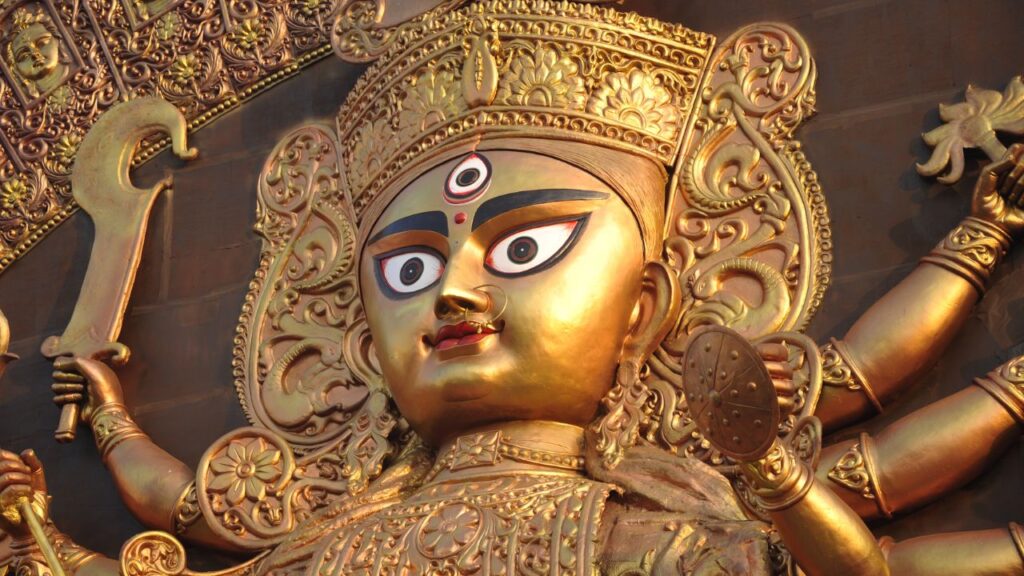
Symbolic Significance of Kali
Hindu philosophy and spirituality find great symbolic meaning in the beginnings of the Goddess Kali and her victory against Mahishasura. Often considered as the personification of time, destruction, and the ultimate ego dissolution—a necessary phase of the road towards enlightenment and emancipation (moksha)
With her dark skin, projecting tongue, and garland of severed heads, Kali’s iconography captures the erasure of the ego and the release of bonds that bind us to the physical world. < Her presence reminds us that confronting and transcending our own death and the transient character of earthly life is the only path to achieve actual freedom.
Kali in Hindu Festivals
Two of the main Hindu celebrations, Navaratri and Durga Puja, clearly show the respect for Goddess Kali.
Navavatri
Nine-night Navaratri is dedicated to honoring the Divine Mother in all her forms—including Kali. Devotees worship the Goddess’s power and grace by means of rites, prayers, and cultural events during this period.
Families in southern India sometimes make complex dioramas, sometimes referred to as golu, featuring episodes from Hindu mythology with Kali taking front stage. The energetic garbo dances in the western regions of the nation, where the Goddess is at the center of the festive circle, also define the event.
Durga Pujas
Celebrated mainly in eastern India, the Durga Puja marks another important celebration of the Goddess Kali. This celebration honors the Mother Goddess’s journey from her house in Kailash to her maternal home on Earth, when she is said to fight fiercely with the asura Mahishasura.
The celebration starts on Mahalaya, the day the Mother Goddess is called upon and her trip to Earth is seen watched. Grand pandals (temporary constructions) are built during the next days, and exquisitely made Goddess idols—often Kali—are revered with tremendous passion.

Kali in Hindu Temples
The many temples honoring Goddess Kali over the Indian subcontinent also reflect her respect. These holy sites are centers of spiritual and cultural activity where followers may commune with the strong presence of the Goddess.
Believed to be one of the 51 Shakti Pithas — holy spots where the severed body parts of the Goddess Sati fell during her immolation, the Kalighat Temple in Kolkata, West Bengal, is among the most well-known Kali temples. The famous picture of Kali in the temple, with her sharp but sympathetic eyes, has come to represent her continuous importance in Hindu customs.
Kali’s Duality and Commitment
Goddess Kali’s image is sometimes one of duality, that of the fierce and the loving as well as the destroyer and the nurturer. Devotees throughout the years have been enthralled by the Goddess’s multifarious character, which helps them to relate to her in their own particular ways.
For some, Kali stands for the final triumph of the divine feminine—a strong force that transcends gender boundaries and questions the patriarchal systems long in control of religious and cultural narratives. For some, she is the reminder of the impermanence of life and the necessity of letting go of attachments, the cycle of life and death embodied.
Whatever one’s perspective, many Hindus still find great and transforming power in their dedication to Goddess Kali. Her attendance in celebrations, temples, and the communal consciousness of the society attests to the Divine Mother’s ongoing relevance in the spiritual and cultural terrain of Hinduism.
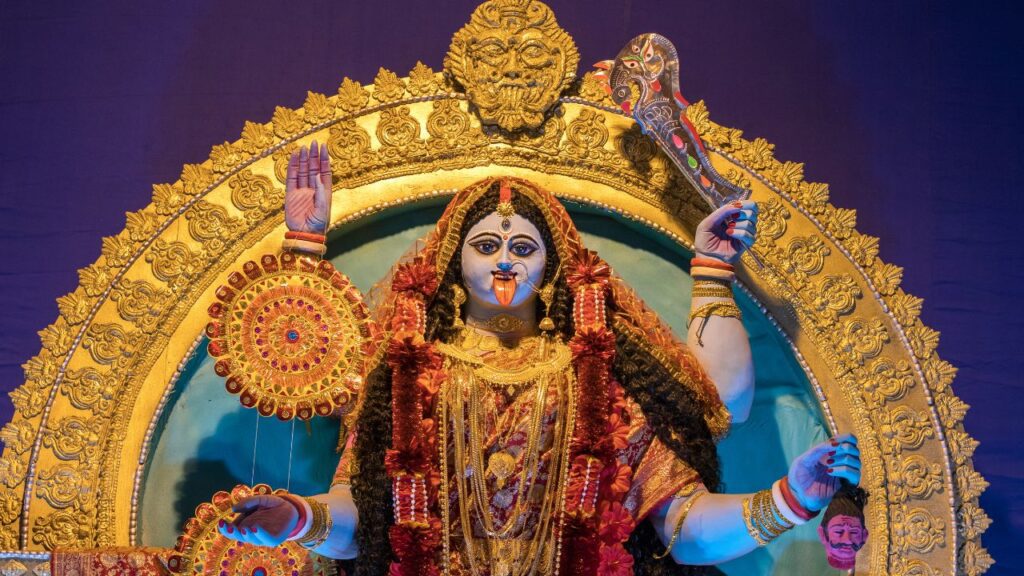
Kali’s Iconography’s Enchanting Power
The images of Goddess Kali are as striking as their legendary roots and stories. In Hindu philosophy and spirituality, her unique physical traits, decorations, and symbolic tools are quite important.
Often characterized as the hue of the night sky, the Goddess’s dark complexion reflects the all-encompassing quality of the Divine Mother, who transcends form and color restrictions. Sometimes taken as a sign of contempt for the material world, her extended tongue represents her capacity to eat and kill the ego.
Many read Kali’s garland of chopped heads and her necklace of human skulls as symbols of the ego’s collapse and the release of attachments. Wielding a range of weapons and tools, her four-armed appearance represents her several powers and her capacity to defend and empower her followers.
Kali’s portrayal standing on the recumbent form of her lover, Shiva, captures the Goddess’s supremacy over the masculine principle and her part as the ultimate source of creation, preservation, and destruction quite powerfully.
Kali inside the Spiritual Realm
Beyond her central participation in Hindu celebrations and temples, Goddess Kali has enthralled spiritual seekers and mystics throughout history. Those who want to go beyond the boundaries of the physical world and reach spiritual emancipation have found great reflection and dedication motivated by the Goddess’s ferocious but sympathetic character.
Among the most well-known spiritual leaders connected with Kali is Bengal’s 19th-century saint, Sri Ramakrishna Paramahamsa. Deeper knowledge of Kali’s multifarious character has come from Ramakrishna’s great experiences with the Goddess, in which he recognized her as the loving and benign Mother.
Kali marks the ultimate truth that transcends the veil of Maya (illusion) for Ramakrishna and other followers: the awareness that the Absolute, the Divine, is both the source and the destroyer of all that is. By means of their dedication and spiritual practices, they aimed to accept Kali’s duality and realize that the road to enlightenment sometimes calls for the ego to be destroyed and the submission to the all-encompassing love of the Goddess.
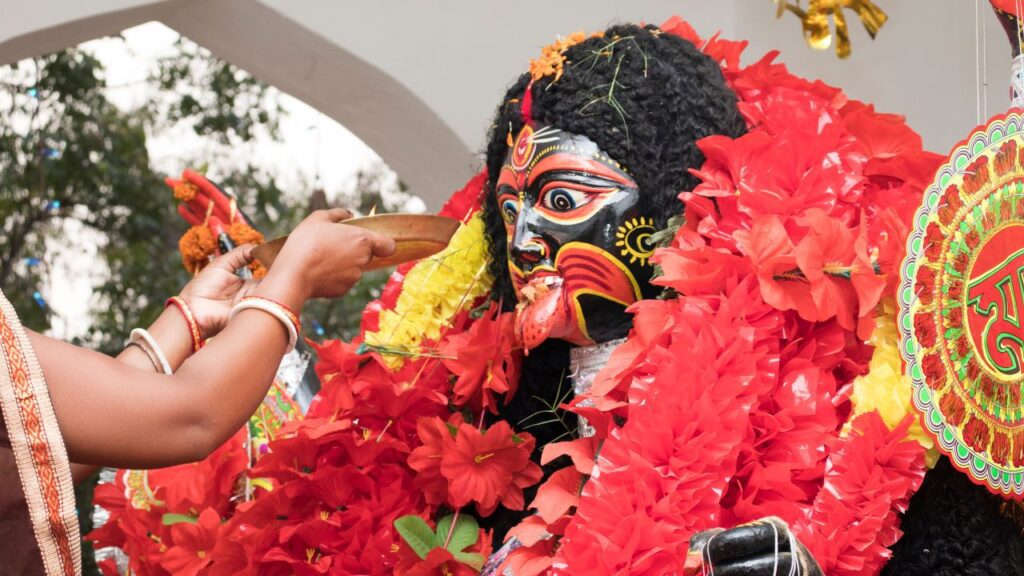
Kali’s Worldwide Attractiveness
Goddess Kali’s fascinating presence appeals to a larger audience all around than only Hinduism. From all backgrounds, artists, academics, and spiritual searchers have been motivated to investigate and understand her relevance by her strong images and great symbolism.
Within the fields of literature and art, Kali’s symbols have inspired many original works. From the vivid paintings and sculptures showing her ferocious but captivating form to the poetic and intellectual works exploring her significance, Kali’s influence has permanently changed the cultural scene.
Furthermore, the increasing curiosity and respect of Hindu spirituality and mythology among non-Hindu viewers reflects the Goddess’s worldwide appeal. The great insights and transforming power of Kali’s lessons are resonating with those looking for more meaning and connection in their life as the globe gets more linked.
Conclusion
Devotees all around the Hindu world still find great resonance in the Goddess Kali, in all her complexity and compelling presence. Her beginnings, symbolism, and part in many celebrations and ceremonies attest to the Divine Mother’s ongoing importance in the spiritual and cultural fabric of Hinduism.
From the great revelations into the nature of the self and the divine to the bloody conflicts against the powers of darkness, Goddess Kali’s legacy cuts across time and space. The Goddess’s ability to inspire, change, and elevate the human spirit is evidence of the ageless wisdom of the Hindu religion even as devotees and searchers interact with her multifarious persona.
#kali #maakali #kalimata #hindu #hindusim
